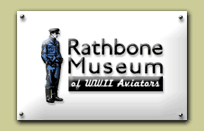 |
|
|
 |
|
 |
|
 |
|
 |
 |
|
 |
 |
|
|
|
 |
|
|
|
A service dress uniform to 1st Lieutenant D. Nicholson, USAAF, 8th AF |
|
|
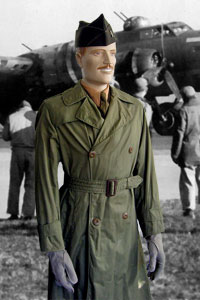 |
|
 |
|
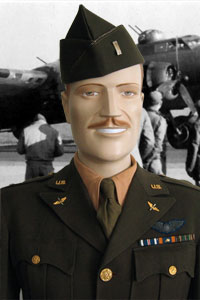 |
|
|
|
Now that the sun is out, Lt. Nicholson has taken off his raincoat. He wears standard issue US Army 'pinks and greens' with the personal choice of a pink private purchase shirt, green tie and green officers overseas cap vs. the visored garrison hat. |
A closer view reveals the standard US officer insignia of US lapel DIs on either side of the lapel along with a pair of branch of service insignia. In this case, he wears the winged prop of the Army Air Force. |
|
|
Lt. Nicholson stands out on the field in front of a B-17. His outfit is that of an American pilot serving with the 8th Air Force in England. The light weight, rubberized raincoat was critical for service in this rainy clime. |
|
|
|
|
|
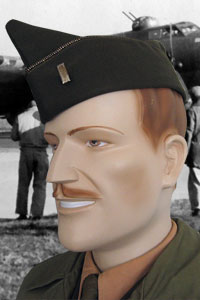 |
|
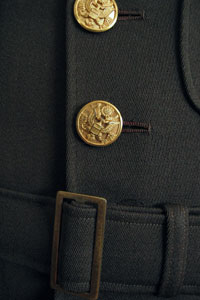 |
|
|
|
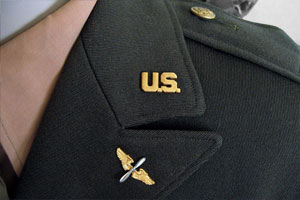 |
|
|
| A closer view of the officers garrison cap with rank insignia on the left front. All officers had gold and black metallic piping on their caps. Enlisted had piping made of branch of service colors. |
|
A close-up view of the DIs and the pink shirt. This shirt is 'pinker' than most and reflects the variation in an item that most officers privately purchased. |
|
The integrated fabric belt and brass buckle. The US Army buttons are two piece brass. |
|
|
|
|
|
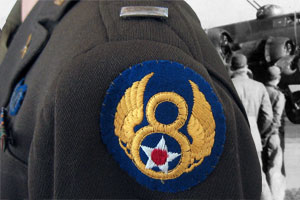 |
|
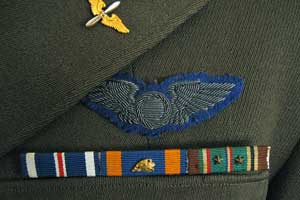 |
|
|
| On his left shoulder, D. Nicholson wears his active duty unit patch for the 8th Air Force. This is a nice example of British made embroidery with a wool felt background and silk thread. |
This is probably the most unique aspect of the uniform. D. Nicholson wears a hand embroidered Observer wing mounted on blue felt. The observer rating began in WWI as a very specific function that later became more specialized as aircraft became more complex. Beginning in WWII, the observer wing was given to crew members who later received their own unique insignia, like Navigators. So either D. Nicholson retained his early rating or he remained a rated observer, a rarer position as the war progressed. The blue felt was an unofficial practice adopted by air force men to signify their belonging to an active combat crew.
The ribbons, from the left, signify the Distinguished Flying Cross, the Air Medal with gold oak leaf cluster (indicating 5 awards) and the European Theater of Operations medal with two campaign stars. |
|
|
|
|
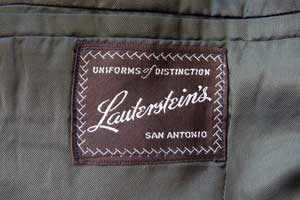 |
|
|
|
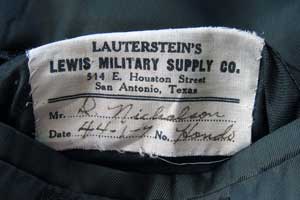 |
|
|
| Most US officers purchased their own uniforms from tailors or department stores with an allowance once they received their commission. San Antonio, Texas was home to a few large air bases including Kelly Field, Randolph Field and Duncand Field. |
The interior label showing the tailors address and Nicholson's name. His tunic is dated January 1944. |
|
|
|
|
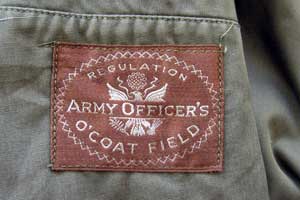 |
|
|
| The interior of the officers raincoat showing the regulation label. |
|
|
|
|
|
|
|
|
© Tod Rathbone |
|
|
|
|
|
|
|
|
|
|
|
|
|
|
|
|
|
|
|
|
|
|
|
|
|
|
|
|
|
|
|
|
|
|
|
|



















